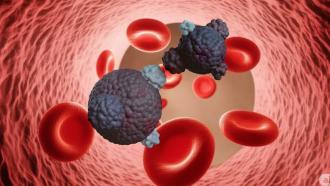
Study identifies the role of DLX1 gene in prostate cancer demonstrating how its elimination leads to reduced carcinogenesis in mice models.
Myriads of molecules in the human body work in tandem, forming complex signalling networks that drive our living system. Some of the molecular interactions are apparent and easy for scientists to identify. Others are less obvious. Understanding these networks give us insights into body functioning, allowing the advancement of medical sciences.
For instance, each of the four molecules named DLX1, AR, ERG, and TMPRSS2 have seemingly unrelated functions. They show specific behaviour in prostate cancer patients.
DLX1 is known to play a critical role in body patterning, for example, the formation of the jaw, nervous system, and skeleton. However, these body patterning genes are known to be highly expressed in cancer. DLX1 plays a significant role during embryo development, but, unrelatedly, 60% of the patients with prostate cancer in the advanced and spreading stages show higher levels of DLX1. AR is a male hormone receptor essential for normal male sexual development. Its overexpression allows prostate cancer to progress to advanced stages.
ERG is a gene decoding regulator, which controls genes involved in the development of cancer. TMPRSS2, the molecule shown to be involved in the coronavirus entry in our respiratory system, is commonly found on the inner lining of various organs. ERG alone is not even expressed in prostate tissues. Still, together with TMPRSS2, genetic rearrangements led to a new combined TMPRSS2-ERG fusion product observed in around half of prostate cancer patients.
In western countries, these molecules are a part of the panel of molecules tested for in the diagnostic screening of prostate cancer. But do these molecules just happen to show rise or fall in their level in prostate cancer, or is there any deeper interrelation? It seems like there is. A team of scientists, led by Prof. Bushra Ateeq from IIT Kanpur, have detailed the role of DLX1 in prostate cancer in their latest study published in Nature Communications.
“Some genes are highly expressed in certain cancers but do not necessarily have a role in the cancer development. But we have found that that's not the case with DLX1,” explains Bushra.
In 2015, their lab found that in Indian prostate cancer patients, around 50% of the cases are positive for TMPRSS2-ERG gene fusion, which led to the production of higher levels of ERG protein. In their latest study, the team has identified the steps that lead to DLX1 expression resulting in the development of prostate cancer, and the following metastatic stage, where cancer begins to spread.
“Patient samples showing higher levels of the product due to TMPRSS2-ERG fusion, namely ERG, also tended to show higher DLX1 levels. Both ERG and AR seemed to drive the DLX1 expression, which we found intriguing. Still, we were puzzled because some patients without TMPRSS2-ERG fusion or ERG also show higher DLX1 levels. We wondered what is the driver for DLX1 in such cases,” Bushra elaborates.
Upon investigation, they found that the ERG and AR both modulate the expression of DLX1 by binding to its regulatory regions. The study by Bushra and her team also show that if one uses a BET inhibitor (a class of anticancer agents), which is known to inhibit aberrant AR signalling, either alone or in combination with anti-androgen drugs to prevent this binding, the DLX1 levels reduce.
They injected lab mice with human prostate cancer cells with higher levels of DLX1. Once the tumour reached a certain mass, they drugged the mice with BET inhibitor, both in combination with anti-androgen and individually. They found that the DLX1 levels came down, and tumour mass reduced considerably. Notably, mice in the treatment group showed a reduced spread of cancer cells to other organs, which often happens in advanced-stage cancer patients. Their study identified that three molecules- ERG, AR and FOXA1 are responsible for the overexpression of DLX1.
“The results of our study ascertain DLX1 as a potentially effective therapeutic target in prostate cancer patients irrespective of TMPRSS2-ERG fusion status. Most importantly, the inhibitors we tested (BET inhibitors) are already in clinical trials and may benefit about ~60% of prostate cancer patients who tend to have higher DLX1 levels,” Bushra clarifies.
The team is now looking at the big data picture of prostate cancer cases across the nation. Genetics has racial bias, and molecular players of prostate cancer in the West may not be the same for patients of Indian origin. “We want to identify the key molecular players involved in prostate cancer progression in patients from India. This finding will aid the development of effective diagnostics and therapies that are especially better suited for the Indian population,” Bushra concludes, talking about the next steps.
This article has been run past the researchers, whose work is covered, to ensure accuracy.






